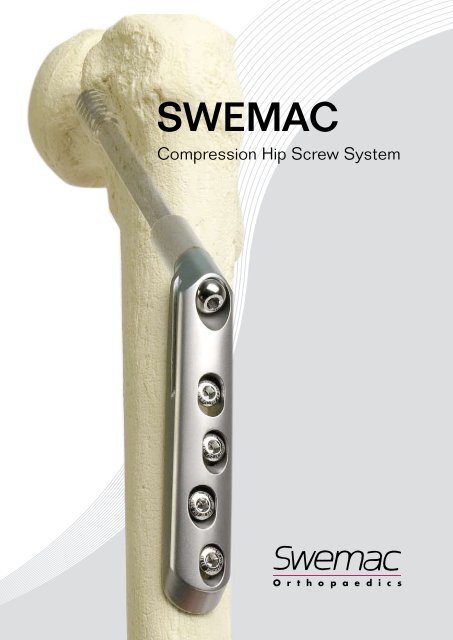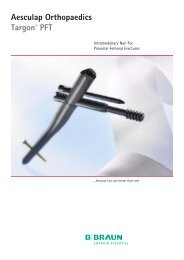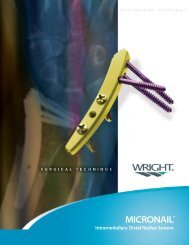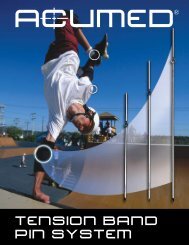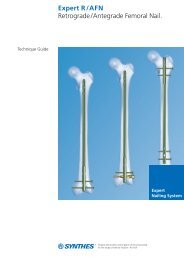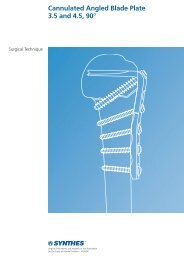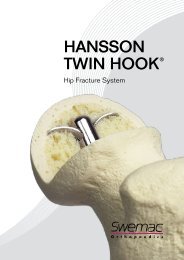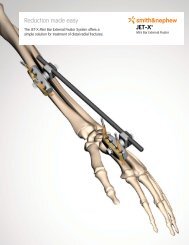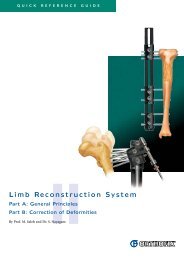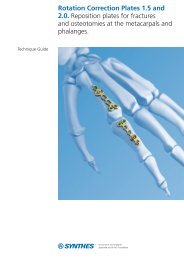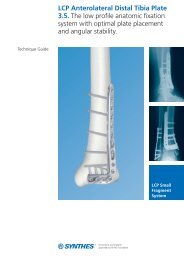sWemaC - Osteosyntese
sWemaC - Osteosyntese
sWemaC - Osteosyntese
You also want an ePaper? Increase the reach of your titles
YUMPU automatically turns print PDFs into web optimized ePapers that Google loves.
SWEMAC<br />
Compression Hip Screw System
SWEMAC<br />
Compression Hip Screw System<br />
This system provides a simple and easy-to-use<br />
solution for all surgeons facing hip fractures.<br />
Offering a wide choice of hip plates combined with<br />
a unique lag screw, and innovative instrumentation.<br />
Each implant is individually sterile packaged<br />
for immediate use and greater inventory control.<br />
All implants are made from stainless steel 316 LVM.<br />
Keyed<br />
Rotational stability of the lag screw in the<br />
plate barrel is ensured through bilateral<br />
flattening of the shaft of the lag screw to<br />
match the inside of the hip plate barrel.<br />
SLIMlineD<br />
Hip plates<br />
Compression screw<br />
The compression screw will allow the surgeon<br />
to compress the fracture peroperatively.<br />
The SWEMAC Hip Plates has a<br />
smoothly curved outer profile and<br />
still main tains an extra ordinary<br />
mechanical strength.<br />
The hip plates are available with<br />
plate/barrel angles 130°, 135°, 140°,<br />
145° and 150°. The plate is also<br />
available in 95° angle for<br />
supracondylar fractures.<br />
The plates are available with<br />
2 to 16 holes.<br />
Selftapping bone screws<br />
Selftapping 4.5 mm cortical bone screws are<br />
used to fix the hip plate to the femoral shaft.<br />
The operation time is reduced as no tapping<br />
is required.<br />
The most proximal hole in the hip<br />
plate will allow the use of a 6.5 mm<br />
selftapping cancellous bone screw.<br />
R 20 curvature<br />
The underside of the hip plate has a R 20<br />
curvature following the radius of the femoral<br />
shaft. It is also partly due to this curvature<br />
that the SWEMAC Hip Plate has been<br />
found to be one of the strongest hip plates<br />
on the market.<br />
The SWEMAC Hip Plate is compatible<br />
with the Hansson Twin Hook.<br />
SWEMAC Dynamic Plate<br />
Patent no: 0101585-8<br />
Periost elevator<br />
When a small incision is required, the distal<br />
part of the hip plate can be used as a periost<br />
elevator to separate the muscle from the bone.
Optimal fixation<br />
An adequate grip in the femoral head is crucial for successful fixation<br />
of hip fractures. The SWEMAC Lag Screw has been designed to<br />
overcome the reduction in strength in the cancellous bone caused by<br />
osteoporosis.<br />
Strength of fixation is dependent upon both implant and<br />
bone properties. If too much bone trabeculae is removed,<br />
the interaction between bone and implant may be destroyed.<br />
To achieve a good fixation, it is vital to save sufficient bone<br />
trabeculae in the femoral head. The special design of the<br />
triple reamer and the SWEMAC Lag Screw minimize the<br />
disruption of the bone trabeculae.<br />
The SWEMAC Lag Screw has four unique features<br />
improving the holding power in the femoral head.<br />
First, it has a conical core. This allows an increase of the<br />
total area of the thread and thereby improving the holding<br />
power in the cancellous bone.<br />
Second, it has gradually decreasing distance between the<br />
threads, starting from the tip. This will compress the bone<br />
and prevent rotation forward.<br />
Blunt Tip<br />
Fourth, the SWEMAC Lag<br />
Screw has a blunt tip in order<br />
to minimize the risk of femoral<br />
head penetration.<br />
Third, the threaded part has the same outer diameter over<br />
the whole length, improving the holding power even further.<br />
The SWEMAC Lag Screw is compatible<br />
with the Medoff Sliding Plate.<br />
SWEMAC Lag Screw<br />
Patent no: 9404035-9<br />
Patent no: 0100573-5
Prevents medial<br />
displacement<br />
The SWEMAC Lateral Support Plate prevents medial displacement<br />
of the shaft relative to the neck and head fragment. A rotationally<br />
unstable neck and head fragment can be additionally stabilized<br />
with a 6.5 mm selftapping cancellous bone screw inserted parallel to<br />
the lag screw.<br />
Adjustable<br />
The lateral support plate allows the surgeon<br />
to adjust the position of the support plate,<br />
depending on the distance between the<br />
plate barrel and the greater trochanter.<br />
This distance will vary depending on the<br />
plate angle.<br />
Dynamic<br />
The lateral support plate will allow dynamic<br />
axial compression to occure between the<br />
fractured lateral cortex (above the plate<br />
barrel) and the femoral shaft.<br />
Anatomic curvature<br />
The under side of the lateral<br />
support plate has an anatomical<br />
curvature templating the greater<br />
trochanter.<br />
Low profile<br />
The lateral support plate has been<br />
designed to minimize soft tissue irritation.<br />
Minimally innovasive<br />
There is no need to extend the incision<br />
further when using the lateral support plate.<br />
The distal part of the hip plate can be used<br />
as a periost elevator in order to separate<br />
the muscle from the bone, creating a<br />
pocket proximal to the entrance hole of<br />
the plate barrel. The lateral support plate<br />
can then be i nserted prior to the insertion<br />
of the hip plate and thereafter connected.<br />
SWEMAC Lateral Support Plate<br />
Patent pending<br />
Fixation<br />
The holes in the lateral support<br />
plate will accept either 4.5 mm<br />
cortical bone screws or<br />
6.5 mm cancellous bone screws.
Innovative<br />
instrumentation<br />
The SWEMAC Angle Guide<br />
A correct placement of the guide pin is the most important step in the<br />
whole operative procedure. The appropriate angle guide is placed on<br />
the femoral shaft. A 3.2 mm guide pin is inserted in the<br />
central hole of the angle guide and advanced into the<br />
femoral head under image intensification. If the first<br />
guide pin is placed in a wrong position, the<br />
angle guide will allow an additional<br />
guide pin to be inserted using the first<br />
guide pin as a reference. There<br />
is therefore no need to change the<br />
position of the angle guide on the<br />
lateral cortex.<br />
Direct length<br />
measurement<br />
The required length of the 4.5 mm cortical<br />
bone screw can be read on the scale of the<br />
drill sleeve against the black mark on the<br />
3.2 mm drill.<br />
Frontal view<br />
Safe reading<br />
Less risk of miss reading the adjusted<br />
length on the triple reamer.<br />
A guide pin is introduced too<br />
superior to the central axis line of<br />
the femoral neck and head.<br />
Lateral view<br />
A second guide pin is introduced in<br />
an optimal position 5 mm inferior to<br />
the first guide pin. The first guide pin<br />
is then removed.<br />
Rigid 3.2 mm guide pin<br />
The rigid 3.2 mm guide pin ensures a quick,<br />
precise and safe lag screw placement. The<br />
threaded tip guarantees a secure seating in<br />
the subcondral bone.<br />
A guide pin is introduced too<br />
posterior to the central axis line of<br />
the femoral neck and head.<br />
A second guide pin is introduced in<br />
an optimal position 5 mm anterior to<br />
the first guide pin. The first guide pin<br />
is then removed.<br />
Stainless steel instrument tray<br />
The instrument tray is made completely<br />
out of stainless steel wire, ensuring good<br />
penetration during steam autoclaving.<br />
For more information, see Operative Technique.<br />
The most distal hole in the SWEMAC Angle Guide<br />
is used for the Medoff Sliding Plate.
Swemac Orthopaedics AB develops and<br />
promotes unique orthopaedic implants and<br />
instruments for fracture treatment and small<br />
joint replacement. Swemac’s products are<br />
promoted worldwide by distributors.<br />
Swemac Orthopaedics AB<br />
Industrigatan 11 • SE-582 77 Linköping • Sweden<br />
Phone +46 (0) 13 37 40 30 • Fax +46 (0) 13 14 00 26<br />
E-mail info@swemac.com<br />
SWEMAC Compression Hip Screw System • 0905


